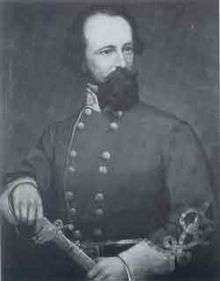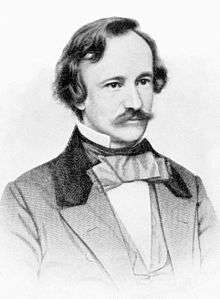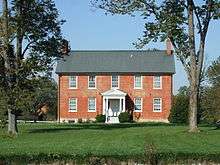J. Johnston Pettigrew
| J. Johnston Pettigrew | |
|---|---|
 | |
| Born |
July 4, 1828 Tyrrell County, North Carolina |
| Died |
July 17, 1863 (aged 35) Bunker Hill, West Virginia |
| Allegiance |
|
| Service/branch |
|
| Years of service | 1861–63 |
| Rank |
|
| Battles/wars | |
James Johnston Pettigrew (July 4, 1828 – July 17, 1863) was an author, lawyer, linguist, diplomat, and a Confederate general in the American Civil War. He was a major leader in the disastrous Pickett's Charge and was mortally wounded a few days after the Battle of Gettysburg during the Confederate retreat to Virginia.
Early years

Johnston Pettigrew was born to Ebenezer and Ann Sheppard Pettigrew in Tyrrell County, North Carolina. His father was of a wealthy family of French Huguenot background[1] His mother and the mother of Union general John Gibbon were first cousins, making Gibbon and Pettigrew second cousins. Pettigrew entered the University of North Carolina at Chapel Hill at the age of 15. He excelled in mathematics and classical languages, and was a member of the Philanthropic Society. He also led his class in fencing and boxing. He earned praise for his achievements from President James K. Polk, who appointed him an assistant professor at the United States Naval Observatory. He then studied law in Baltimore and joined the firm of his father's first cousin, James Louis Petigru in Charleston, South Carolina, followed by a trip to Germany to study civil law. He traveled around Europe for seven years, where he learned to speak and write French, German, Italian, and Spanish, and to read Greek, Hebrew, and Arabic. He wrote a travel book, Notes on Spain and the Spaniards, and spent time in the diplomatic service.
Returning to the U.S., Pettigrew was elected to the South Carolina legislature in 1856. Despite his gift of foreign languages and civil knowledge, Pettigrew leaned toward the military as a way to serve his country and his state. In December 1860, he was serving as an aide to the governor of South Carolina and the following April participated in the negotiations between the governor's office, South Carolina military authorities, and the Union commander of Fort Sumter in Charleston Harbor.
Civil War
When war began, Pettigrew joined the Hampton Legion, a force raised in South Carolina by Wade Hampton, as a private, although he quickly accepted a commission as colonel of the 1st South Carolina Rifles. He returned to North Carolina to command the 12th (later renamed the 22nd) North Carolina Infantry. Both Jefferson Davis and Gen. Joseph E. Johnston urged him to accept higher command, but he declined because of his lack of military experience. However, as the need for qualified officers in the Confederate States Army became acute, the new colonel was soon ordered to Virginia to accept a promotion to brigadier general on February 26, 1862.
When a young relative requested a "safe place" on Pettigrew's staff, he replied, "I assure you that the most unsafe place in the Brigade is about me. By all means let him get rid of this idea of a safe place, which he will regret after time. The post of danger is certainly the post of honor." He was true to his word.
Peninsula Campaign
During the Peninsula Campaign in the summer of 1862, Pettigrew was severely wounded at the Battle of Seven Pines. He was hit by a Minié ball that damaged his throat, windpipe, and shoulder. Pettigrew nearly bled to death, and while lying wounded, he received another bullet wound in the arm and was bayoneted in the right leg. Believing his wounds mortal, Pettigrew didn't permit any of his men to leave the ranks to carry him to the rear. Left for dead on the field, he recovered consciousness as a Union prisoner of war.[2] Exchanged two months later, the general recovered from his wounds, spent the fall commanding a brigade in Maj. Gen. Daniel Harvey Hill's division around Richmond, and the winter commanding a brigade in North Carolina and southern Virginia. He returned to his North Carolina brigade just in time to begin the Gettysburg Campaign in June 1863.
Gettysburg Campaign
The Confederate War Department had assigned Pettigrew's Brigade to Gen. Robert E. Lee's Army of Northern Virginia, and Pettigrew traveled to Fredericksburg, Virginia, to rejoin that army in late May. Pettigrew's Brigade was the strongest in Maj. Gen. Henry Heth's Division of Lt. Gen. A.P. Hill's Third Corps. Freshly uniformed and armed with rifles from state military depots, his regiments presented a fine military appearance during the march through Maryland and Pennsylvania. Some of his regimental officers were also members of the North Carolina planter "aristocracy," including Colonel Collett Leventhorpe leading the 11th North Carolina Infantry and twenty-one-year-old Harry Burgwyn at the head of the 26th North Carolina Regiment, the largest Confederate regiment at Gettysburg. Not having been in serious combat for nearly a year, his brigade mustered a strength over 2,500 officers and men.[3]
Pettigrew's Brigade tangled with the Iron Brigade on July 1, 1863, at the McPherson and Herbst farms to the west of Gettysburg, where all four of his regiments suffered devastating losses—over 40 percent—but were successful in driving the Union forces off of McPherson's Ridge.[3] General Pettigrew assumed command of the division after the wounding of Gen. Heth that afternoon, and attempted to reorganize the battered division during the next day's battle as they lay behind Seminary Ridge.
Pickett's Charge
On July 3, Lee selected Pettigrew's division to march at the left of Maj. Gen. George Pickett's in the famous infantry assault now known as Pickett's Charge (although some recent historians have used the name "Pickett-Pettigrew-Trimble Assault" to describe it because Pickett led only one third of men in the attack). This was an error on Lee's part. He did not consult with Pettigrew to find out the terrible condition of the division.
As the division advanced, it received murderous fire. Pettigrew's horse was shot out from under him, and he continued on foot. Reaching within 100 yards of the stone wall on Cemetery Ridge partially held by his cousin John Gibbon, he was severely wounded in the left hand by canister fire. Despite the great pain he was in, Pettigrew remained with his soldiers until it was obvious that the attack had failed. Holding his bloody hand, the despondent officer walked toward Seminary Ridge and encountered General Lee. Pettigrew attempted to speak, but Lee, seeing the horrible wound, spoke first: "General, I am sorry to see you are wounded; go to the rear." With a painful salute, Pettigrew said nothing but continued to the rear.
Falling Waters and death
General Pettigrew continued to command the division during the retreat to the Potomac River until Heth recovered. Stopped by the flooded Potomac River at Falling Waters, West Virginia, Pettigrew's brigade was deployed in a dense skirmish line on the Maryland side protecting the road to the river crossing. Union cavalry probed the southern defenses throughout the night as Lee's army crossed the pontoon bridges into West Virginia. On the morning of July 14, Pettigrew's brigade was one of the last Confederate units still north of the Potomac River, when the Union troopers closed in. On foot and in the front line, Pettigrew was directing his soldiers when he was shot by a Union cavalryman from the Michigan Brigade at close range, the bullet striking him in the abdomen. He was immediately carried to the rear and across the Potomac, having refused to be left in federal hands. He died three days later at Edgewood Manor plantation near Bunker Hill, West Virginia.[4] His brigade, which lost an estimated 56% casualties, had been ruined as an effective combat organization.[5]


Legacy

The loss of Pettigrew emotionally devastated his family and there was an official day of mourning held for him in North Carolina. His death also affected Lee who remarked, "The army has lost a brave soldier and the Confederacy an accomplished officer."[6] General Pettigrew's body was returned to North Carolina and interred at his family estate, "Bonarva," which is now part of Pettigrew State Park in Washington and Tyrrell Counties.
General James Johnston Pettigrew Camp #1401 of the Sons of Confederate Veterans in Lenoir, North Carolina, was named for the fallen officer.
In World War II, the United States liberty ship SS James J. Pettigrew was named in his honor.
In popular media
Pettigrew was portrayed by actor George Lazenby in the 1993 film Gettysburg.
Notes
- ↑ Tagg, p. 343.
- ↑ Hess, pp. 38-40.
- 1 2 Busey & Martin, p. 286.
- ↑ Don C. Wood (n.d.). "National Register of Historic Places Inventory Nomination Form: Edgewood" (PDF). State of West Virginia, West Virginia Division of Culture and History, Historic Preservation. Retrieved 2011-06-02.
- ↑ Gottfried, p. 606.
- ↑ Official Records, Series 1, Vol. 27, Part 3, page 1016.
References
- Busey, John W., and David G. Martin. Regimental Strengths and Losses at Gettysburg. 4th ed. Hightstown, NJ: Longstreet House, 2005. ISBN 0-944413-67-6.
- Eicher, John H., and David J. Eicher. Civil War High Commands. Stanford, CA: Stanford University Press, 2001. ISBN 0-8047-3641-3.
- Gottfried, Bradley M. Brigades of Gettysburg. New York: Da Capo Press, 2002. ISBN 0-306-81175-8.
- Hess, Earl J. Lee's Tar Heels: The Pettigrew-Kirkland-MacRae Brigade. Chapel Hill: University of North Carolina Press, 2002. ISBN 0-8078-2687-1.
- Tagg, Larry. The Generals of Gettysburg. Campbell, CA: Savas Publishing, 1998. ISBN 1-882810-30-9.
- U.S. War Department. The War of the Rebellion: a Compilation of the Official Records of the Union and Confederate Armies. Washington, DC: U.S. Government Printing Office, 1880–1901.
Further reading
- Wilson, Clyde N. Carolina Cavalier: The Life and Mind of James Johnston Pettigrew. Athens: University of Georgia Press, 1990. ISBN 978-0-8203-1201-9.
- Gragg, Rod. Covered With Glory: The 26th North Carolina Infantry at Gettysburg. New York: HarperCollins, 2000. ISBN 978-0-06-017445-3.
- Trescot, William Henry. Memorial of the Life of J. Johnston Pettigrew: Brigadier General of the Confederate States Army. Charleston, SC: J. Russell, 1870. OCLC 3557938.
External links
- "J. Johnston Pettigrew". Find a Grave. Retrieved 2008-06-27.
- National Park Service biography
- Pettigrew State Park
- Photos of Pettigrew at the Wayback Machine (archived February 8, 2008)
- Confederate memorial addresses : Monday, May 11, 1885, New Bern, N. C (1886)- includes biographical sketch of James Johnston Pettigrew
|